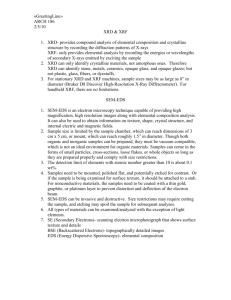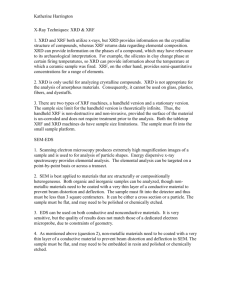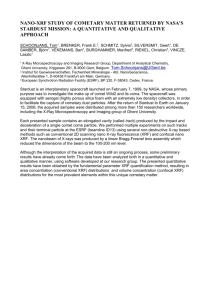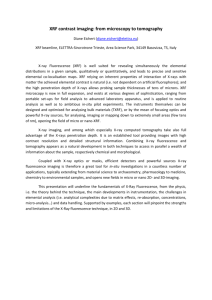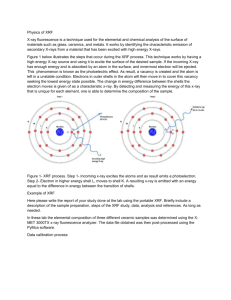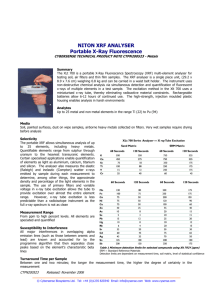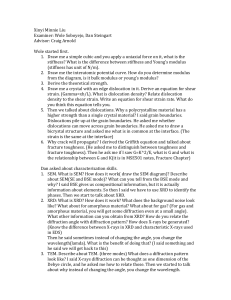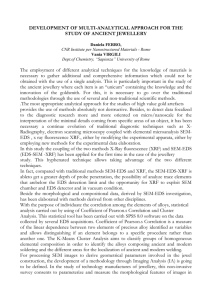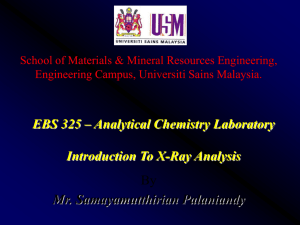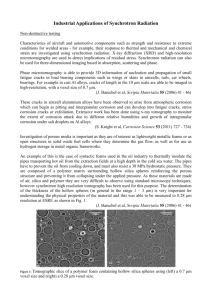XRD-XRF-SEM-EDS
advertisement
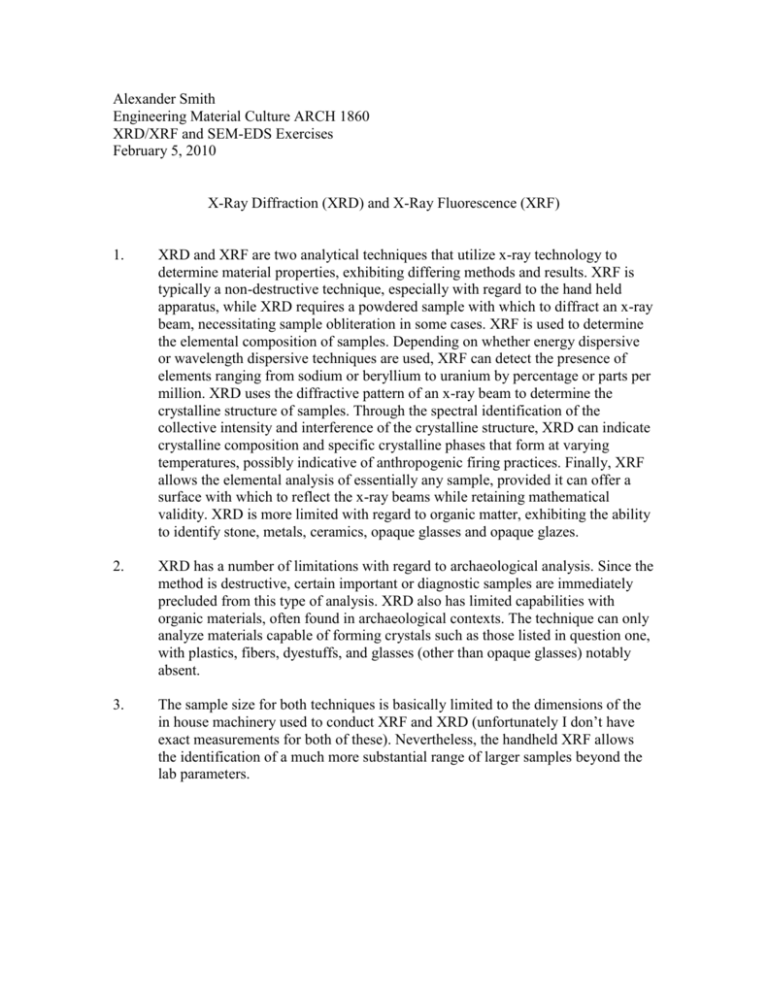
Alexander Smith Engineering Material Culture ARCH 1860 XRD/XRF and SEM-EDS Exercises February 5, 2010 X-Ray Diffraction (XRD) and X-Ray Fluorescence (XRF) 1. XRD and XRF are two analytical techniques that utilize x-ray technology to determine material properties, exhibiting differing methods and results. XRF is typically a non-destructive technique, especially with regard to the hand held apparatus, while XRD requires a powdered sample with which to diffract an x-ray beam, necessitating sample obliteration in some cases. XRF is used to determine the elemental composition of samples. Depending on whether energy dispersive or wavelength dispersive techniques are used, XRF can detect the presence of elements ranging from sodium or beryllium to uranium by percentage or parts per million. XRD uses the diffractive pattern of an x-ray beam to determine the crystalline structure of samples. Through the spectral identification of the collective intensity and interference of the crystalline structure, XRD can indicate crystalline composition and specific crystalline phases that form at varying temperatures, possibly indicative of anthropogenic firing practices. Finally, XRF allows the elemental analysis of essentially any sample, provided it can offer a surface with which to reflect the x-ray beams while retaining mathematical validity. XRD is more limited with regard to organic matter, exhibiting the ability to identify stone, metals, ceramics, opaque glasses and opaque glazes. 2. XRD has a number of limitations with regard to archaeological analysis. Since the method is destructive, certain important or diagnostic samples are immediately precluded from this type of analysis. XRD also has limited capabilities with organic materials, often found in archaeological contexts. The technique can only analyze materials capable of forming crystals such as those listed in question one, with plastics, fibers, dyestuffs, and glasses (other than opaque glasses) notably absent. 3. The sample size for both techniques is basically limited to the dimensions of the in house machinery used to conduct XRF and XRD (unfortunately I don’t have exact measurements for both of these). Nevertheless, the handheld XRF allows the identification of a much more substantial range of larger samples beyond the lab parameters. Scanning Electron Microscopy (SEM) and Energy Dispersive X-Ray Spectroscopy (EDS) 1. SEM-EDS is a non-destructive combination of high magnification microscopy (SEM) and elemental analysis (EDS). SEM allows a visual inspection of sample surfaces at micron level clarity, while the EDS employs x-ray spectroscopy to determine elemental composition. 2. The SEM has the capability of analyzing any organic or inorganic material under certain conditions. Organic samples must be desiccated somehow before analysis, preventing live specimens from analysis (also hindered by the vacuum chamber). Size limits are determined by the sample chamber or 5cm x 3cm. Cross-sections, loose flakes, and whole objects (depending on the size of the object) can all be analyzed by SEM, though each may require different methods of preparation. 3. Although EDS is fairly accurate, presumably on par with EDXRF, the elemental composition analysis may be hindered by a number of preparation processes for SEM. Non-conducting substances require a thin coat of conductive metal, while any sample may require mounting and polishing in an epoxy resin, most likely interfering with the accuracy of the EDS. 4. Certain samples require special preparation depending on the type of material and the information desired. Generally, metals require little preparation beyond simple mounting (not necessarily in resin). Non-metals must be coated with some sort of conductive substance (for example gold, graphite or platinum) in order to prevent electron beam distortion. If back-scattered detector imaging is desired, samples are embedded in an epoxy resin and polished to a flat surface. 5. While the SEM-EDS system is non-invasive, through certain methods of preparation, the coatings and mountings described in question four can be very destructive. 6. Seemingly any type of sample smaller than 5cm x 3cm can be analyzed provided it is dead, dry, and somehow conductive. 7. Secondary electron images provide detailed renderings of the surface texture of the sample. Back-scattered electron images create visual representations of compositional information based on the heterogeneity of the material. Energy dispersive x-ray spectroscopy is an elemental analysis similar to XRF and attached to the SEM, utilizing the same sample chamber.
